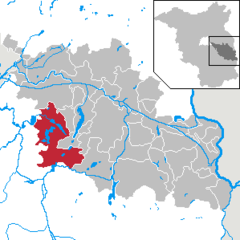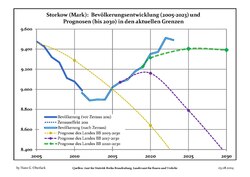
Schwedt is a town in Brandenburg, in northeastern Germany. With the official status of a Große kreisangehörige Stadt, it is the largest town of the Uckermark district, located near the river Oder, which forms the border with Poland.
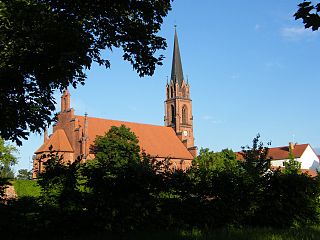
Guben is a town on the Lusatian Neisse river in Lower Lusatia, in the state of Brandenburg, in eastern Germany. Located in the Spree-Neiße district, Guben has a population of 20,049. It is a divided city on the border between Germany and Poland, having been separated into Guben and Gubin in 1945.
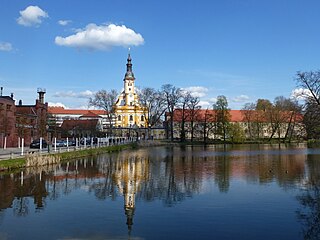
Neuzelle is a municipality in the Oder-Spree district of Brandenburg, Germany, the administrative seat of Amt Neuzelle. It is best known for Cistercian Neuzelle Abbey and its Neuzeller Kloster Brewery.

Doberlug-Kirchhain is a German town in the district of Elbe-Elster, Lower Lusatia, Brandenburg.

Lübbenau is a town in the Upper Spree Forest-Lusatia District of Brandenburg, Germany. It is located in the bilingual German/Sorbian region of (Lower) Lusatia, on the river Spree, where this forms a large inland delta surrounded by woodland, called "Spree Forest", about 82 km (51 mi) southeast of Berlin. The town is best known through the incorporated villages of Lehde/Lědy and Leipe/Lipje, villages where there just exist anabranches of the Spree River instead of streets.

Forst (Lausitz) (German) or Baršć (Łužyca) (Lower Sorbian, pronounced[ˈbarɕtɕˈwuʒɨtsa]) is a town in Lower Lusatia, Brandenburg, in eastern Germany. It lies east of Cottbus, on the Lusatian Neisse river which is also the German-Polish border. It is the capital of the Spree-Neiße district. It is known for its rose garden and textile museum. The town's population is 18,651. In Forst, there is a railway bridge across the Neiße belonging to the line Cottbus–Żary which is serviced by regional trains and a EuroCity train between Hamburg and Kraków (2011). There is also a road bridge across the river north of Forst.

Fürstenwalde/Spree is the most populous town in the Oder-Spree District of Brandenburg, in eastern Germany.

Senftenberg (German) or Zły Komorow is a town in Lower Lusatia, Brandenburg, in eastern Germany, capital of the Oberspreewald-Lausitz district.

Erkner is a town in the Oder-Spree District of Brandenburg, Germany, located on the south-eastern edge of the German capital city Berlin.

Kolkwitz is a municipality in the district of Spree-Neiße, in Lower Lusatia, Brandenburg, Germany.

Beeskow is a town in Brandenburg, in eastern Germany, and capital of the Oder-Spree district. It is situated on the river Spree, 30 km southwest of Frankfurt an der Oder.
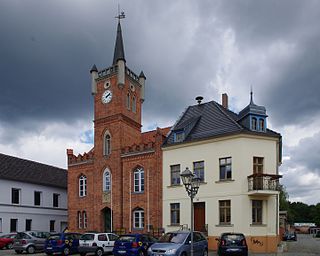
Drebkau is a town in the district of Spree-Neiße, in Lower Lusatia, in Brandenburg, in eastern Germany. It is situated 14 km (9 mi) southwest of Cottbus.

Friedland is a town in the Oder-Spree district, in Brandenburg, Germany. It is situated in the historic Lower Lusatia region, about 8 km (5.0 mi) south of Beeskow, and 39 km (24 mi) north of Cottbus.

Sonnewalde is a town in the Elbe-Elster district, in Lower Lusatia, Brandenburg, Germany. It is situated 8 km northwest of Finsterwalde.

Neißemünde is a municipality in the Oder-Spree district, in Brandenburg, Germany. It belongs to the Amt Neuzelle, which has its administrative seat in the neighbouring Neuzelle municipality.
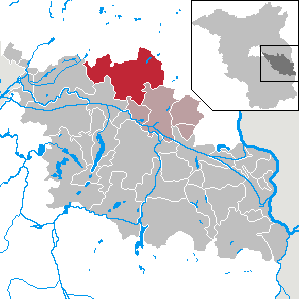
Steinhöfel is a municipality in the Oder-Spree district, in Brandenburg, Germany. Since the beginning of 2019 it belongs to the collective municipality "Amt Odervorland"

Tauche is a municipality on both sides of the river Spree in the Oder-Spree district, in Brandenburg, Germany. The large municipality consists of 12 parts or villages with other local parts/settlements, respectively. The seat of the municipal administration is located in the village of the same name.

Vogelsang is a municipality in the Oder-Spree district, in Brandenburg, Germany. It is located near the border with Poland.

Neuhausen/Spree is a municipality in the district of Spree-Neiße, in Lower Lusatia, Brandenburg, Germany.

Schenkendöbern is a municipality in the district of Spree-Neiße, in Lower Lusatia, Brandenburg, Germany.

